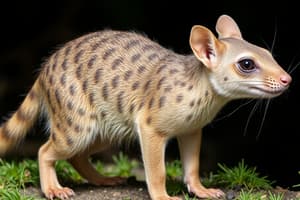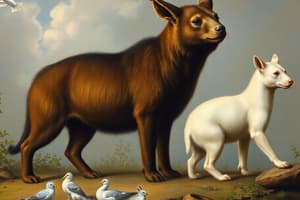Podcast
Questions and Answers
What is the definition for Infraclass Metatheria?
What is the definition for Infraclass Metatheria?
- 50 teeth, sharply cusped
- Large size; prehensile tail
- Possesses auditory bulla (correct)
- 40 or fewer teeth
What are the distinctive dental features of Order Didelphimorphia?
What are the distinctive dental features of Order Didelphimorphia?
50 teeth, sharply cusped; I = 5/4; molars dilambdodont.
Which family is associated with Didelphis virginiana?
Which family is associated with Didelphis virginiana?
Family Didelphidae.
What describes the cranium of Order Dasyuromorphia?
What describes the cranium of Order Dasyuromorphia?
What is the tooth formula for the Tasmanian devil (Sarcophilus harrisii)?
What is the tooth formula for the Tasmanian devil (Sarcophilus harrisii)?
List the characteristics of Order Diprotodontia.
List the characteristics of Order Diprotodontia.
What does the interorbital region of Trichosurus sp. (brush-tailed possum) look like?
What does the interorbital region of Trichosurus sp. (brush-tailed possum) look like?
What is unique about the molars of Phascolarctos cinereus (koala)?
What is unique about the molars of Phascolarctos cinereus (koala)?
What is the size range for GLS in Macropus rufus (red kangaroo)?
What is the size range for GLS in Macropus rufus (red kangaroo)?
What is the interorbital feature of Vombatus sp. (wombat)?
What is the interorbital feature of Vombatus sp. (wombat)?
Flashcards are hidden until you start studying
Study Notes
Infraclass Metatheria
- Commonly referred to as "Marsupials"
- Characterized by inflected angular process of dentary
- Features include palatal vacuities and a small braincase
- Presence of auditory bulla is typical
Order Didelphimorphia
- Contains 50 teeth with sharply cusped morphology
- Dental formula includes I = 5/4
- Molars are dilambdodont
- Notable pronounced sagittal crest present
Family Didelphidae
- Includes Didelphis virginiana (Virginia opossum)
- Recognized for its large size, prehensile tail, and pouch
- Exhibits an opposable hallux and features epipubic bones
- Shares the characteristic of having 50 teeth
Order Dasyuromorphia
- Consists of 46 or fewer teeth
- Notable for large canines and tritubercular molars
- Moderate sagittal crest observed
- Cranium is square and blocky in shape
Family Dasyuridae
- Includes Sarcophilus harrisii (Tasmanian devil)
- Dental formula is noted as I = 4/3
Order Diprotodontia
- Characterized by 40 or fewer teeth
- Cheekteeth have rounded cusps; canines may be reduced or absent
- Presents a partial diastema and a very large, sometimes procumbent, first lower incisor
- Incisors do not exceed three upper or two lower in number
Family Phalangeridae
- Represents Trichosurus sp. (brush-tailed possum)
- Dental formula is I = 3/1, C = 1/0; upper incisors roughly equal in size
- Interorbital region is constricted
- Molars are identified as quadritubercular
Family Phascolarctidae
- Includes Phascolarctos cinereus (koala)
- Dental formula is I = 3/1, C = 1/0; with I^1 much larger than I^2 or I^3
- Characterized by broad interorbital region (greater than Trichosurus)
- Notable for greatly inflated mastoids and very long paraoccipital processes
- Molars are bilophodont
Family Macropodidae
- Includes Macropus rufus (red kangaroo)
- Dental formula is I = 3/1, C = 0/0
- Glenoid length (GLS) exceeds 185mm
- Features very long paraoccipital processes
- Molars are bilophodont
Family Vombatidae
- Represents Vombatus sp. (wombat)
- Dental formula is I = 2/2, C = 0/0
- Has a broad interorbital region
- Glenoid length (GLS) is greater than 165mm
Studying That Suits You
Use AI to generate personalized quizzes and flashcards to suit your learning preferences.




